Intel SSD 730 (480GB) Review: Bringing Enterprise to the Consumers
by Kristian Vättö on February 27, 2014 12:00 PM EST- Posted in
- Storage
- SSDs
- Intel
- Intel SSD 730
Random Read/Write Speed
The four corners of SSD performance are as follows: random read, random write, sequential read and sequential write speed. Random accesses are generally small in size, while sequential accesses tend to be larger and thus we have the four Iometer tests we use in all of our reviews.
Our first test writes 4KB in a completely random pattern over an 8GB space of the drive to simulate the sort of random access that you'd see on an OS drive (even this is more stressful than a normal desktop user would see). I perform three concurrent IOs and run the test for 3 minutes. The results reported are in average MB/s over the entire time. We use both standard pseudo randomly generated data for each write as well as fully random data to show you both the maximum and minimum performance offered by SandForce based drives in these tests. The average performance of SF drives will likely be somewhere in between the two values for each drive you see in the graphs. For an understanding of why this matters, read our original SandForce article.

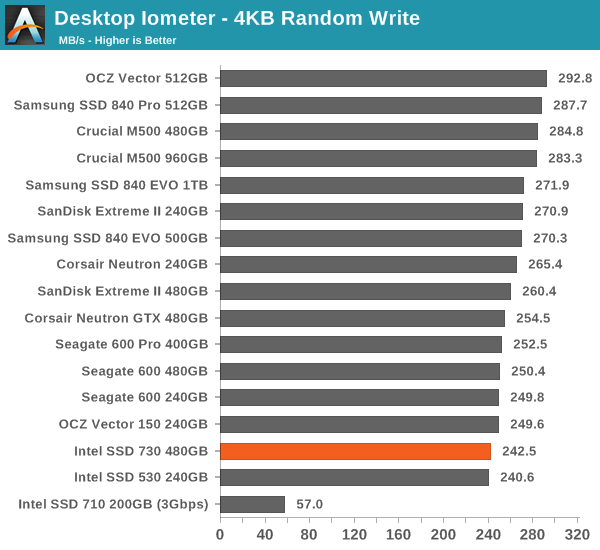
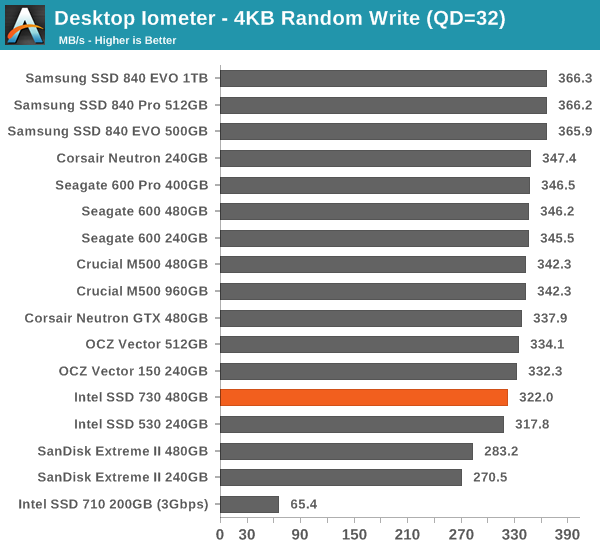
The SSD 730 isn't the fastest in peak performance because that's irrelevant in the enterprise space. We are still looking at decent random write performance and the random read performance is actually surprisingly good.
Sequential Read/Write Speed
To measure sequential performance I ran a 1 minute long 128KB sequential test over the entire span of the drive at a queue depth of 1. The results reported are in average MB/s over the entire test length.
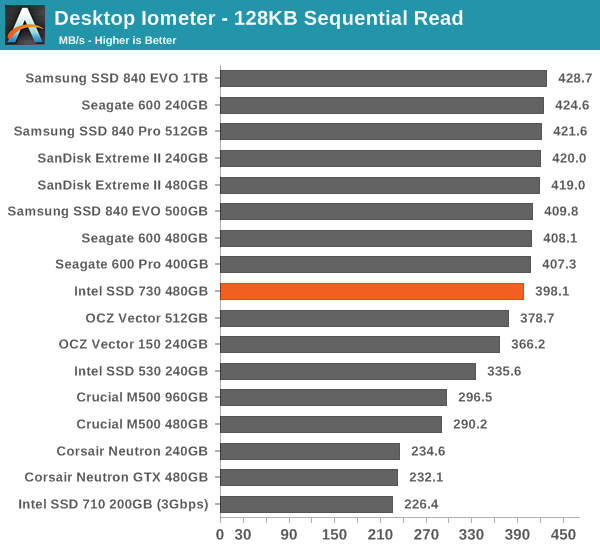
The same goes for sequential performance: the 730 is an average performer with focus on consistency.
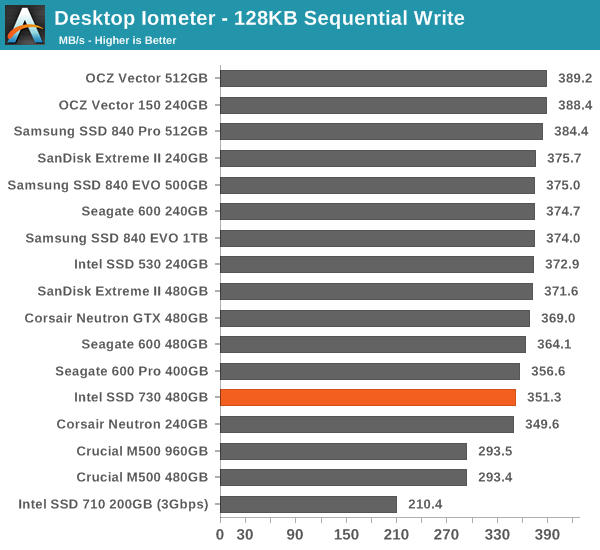
AS-SSD Incompressible Sequential Read/Write Performance
The AS-SSD sequential benchmark uses incompressible data for all of its transfers. The result is a pretty big reduction in sequential write speed on SandForce based controllers.
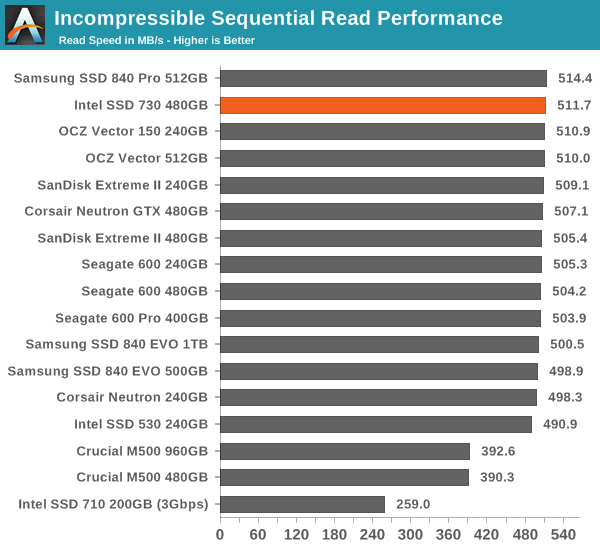
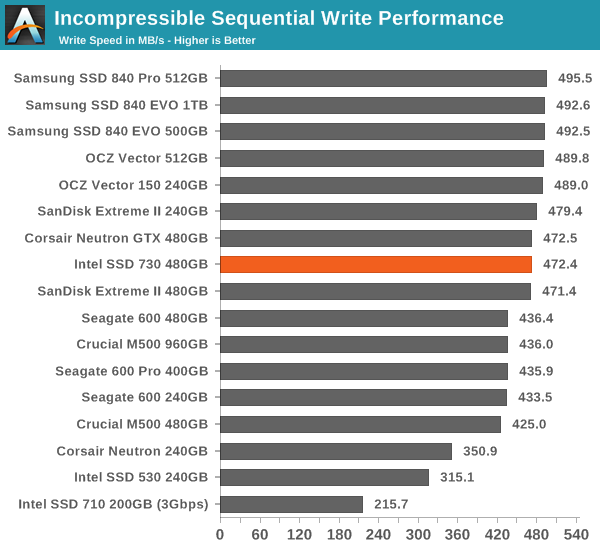










96 Comments
View All Comments
emn13 - Sunday, March 2, 2014 - link
It's interesting to note that both Crucial's M500 and intel's 730 have power-loss protection and a fairly high idle power. Does power-loss protection imply a high idle power?Kristian Vättö - Sunday, March 2, 2014 - link
The M500 supports low-power states (HIPM+DIPM) so in a mobile environment the power consumption is much lower: http://www.anandtech.com/bench/SSD/732hojnikb - Wednesday, March 5, 2014 - link
Is this related to devsleep or do older chipsets support that kind of low power consumption aswell ?Because in some reviews, m500 has quite high idle power consumption...
Kristian Vättö - Wednesday, March 5, 2014 - link
This isn't DevSleep, it lower the idle power consumption even more. This is just HIPM+DIPM (Host/Device Initiated Link Power Management), which is supported by older chipsets as well. However, note that only mobile chipsets support HIPM+DIPM, which is why the power consumption is significantly higher when tested in a desktop environment (like most reviewers do).amddude10 - Friday, November 28, 2014 - link
The power loss protection in crucial drives like the m500 is supposedly very incomplete, and not nearly as good as it is with the 730, or in enterprise drives, so its comparing apples and oranges. I would however say that SSD's which are going to be used in laptops are in much less need of power loss protection, but more in need of low power consumption, whereas SSD's that are intended for desktop use don't need low power consumption, and are in much higher need of power loss protection.CeceliaAFolger - Sunday, March 2, 2014 - link
hywoolfe9998 - Sunday, March 2, 2014 - link
This doesn't strike me as an especially impressive product given what is already out there. Frankly, it seems that SSD technology has settled to the point where the only thing that matters any more is price/capacity. Find me half TB SSD for $200 and I'll care.hojnikb - Wednesday, March 5, 2014 - link
U can get m500 480GB for ~250$ or less if u find a deal. Thats pretty cheap, if you ask me..RAYBOYD44 - Monday, March 3, 2014 - link
til I looked at the receipt for $5432 , I accept that...my... cousin had been truley bringing home money part-time on there computar. . there aunts neighbour had bean doing this for only about 1 year and just paid for the mortgage on their home and purchased BMW M3 .Neo Zuko - Monday, March 3, 2014 - link
I was a big fan of the Sata II Intel SSDs but for Sata III I switched to the Samsung 830 Pro and then the Samsung 840 Pro as my SSD of choice. Seems it's time change up again to the SanDisk Extreme II (which was mentioned to be the new favorite SSD) and or the Intel 730 here.However the Intel 730, for all it does well, does not seem to be completely optimized for the average home PC workload and the top performance is suffering. And you can't use it in a laptop. These seem to be big deal breakers to me. Given those limitations it seems the SanDisk Extreme II would still be Anandtech's favorite SSD. Did I get that right? And would the SanDisk Extreme II work well in a PS4 without trim? And as an aside, I would not mind a better paragraph as to why the SanDisk is a favorite. Is it the near Intel constancy combined with the fast performance - like a best of both worlds thing? Also when is SanDisk releasing that enterprise lite version of the Extreme II with power failure features?